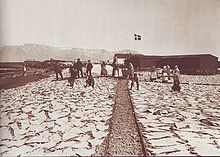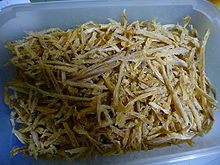- Dried and salted cod
-
Dried and salted cod, often called salt cod or clipfish (klippfisk in Norwegian, see also other names), is cod which has been preserved by drying after salting. Cod which has been dried without the addition of salt is called stockfish.
With the sharp decline in the world stocks of cod due to overfishing, other white fish are often used instead. Sometimes these other species are labeled as such, and sometimes still misleadingly called "salt cod", so the term has become to some extent a generic name.
Dried and salted cod has been produced in Canada, Iceland, Faroe Islands, Norway and Portugal for over 500 years. It forms a traditional ingredient of the cuisine of many countries around the Atlantic. Traditionally it was dried outdoors by the wind and sun, but today it is usually dried indoors with the aid of electric heaters.
Contents
History
The production of salt cod dates back at least 500 years, to the time of the European discoveries of the Grand Banks off Newfoundland.[citation needed] It formed a vital item of international commerce between the New World and the Old, and formed one leg of the so-called triangular trade. Thus it spread around the Atlantic and became a traditional ingredient not only in Northern European cuisine, but also in Mediterranean, West African, Caribbean, and Brazilian cuisines.
The drying of food is the world's oldest known preservation method, and dried fish has a storage life of several years. Drying preserves many nutrients and is said to make the codfish tastier.[citation needed] The method was cheap, the work could be done by the fisherman or his family, and the resulting product was easily transported to market. Salting became economically feasible during the 17th century, when cheap salt from southern Europe became available to the maritime nations of northern Europe.
Traditionally, salt cod was dried only by the wind and the sun, hanging on wooden scaffolding or lying on clean cliffs or rocks near the seaside.
Names
Dried cod and the dishes made from it are known by many different names, as it became part of the cuisine of many European nations. For example, it is known as bacalhau (Portuguese), bacalao (Spanish), bakaiļao (Basque), bacallà (Catalan), morue (French), baccalà (Italian), ráktoguolli/goikeguolli (Sami), klippfisk/clipfish (Scandinavian), saltfiskur (Icelandic), bakalar (Croatian), and Saltfish (Caribbean).
The word compound bacal- and its variants are of unknown origin; explorer John Cabot reported that it was the name used by the indigenous inhabitants of Newfoundland.[1] When explorer Jacques Cartier 'discovered' the mouth of the St. Lawrence River in what is now Canada and claimed it for France, he noted the presence of a thousand Basque boats fishing for cod.
Process
The fish is beheaded and eviscerated, often on board the boat or ship. (This is feasible with whitefish, whereas it would not be with oily fish.) It is then salted and dried ashore. Traditionally the fish was sun-dried on rocks or wooden frames, but today it is mainly dried indoors by electrical heating. It is sold whole or in portions, with or without bones.
Species of fish
Traditionally salt cod was made exclusively of cod. After the collapse of the Grand Banks (and other) cod stocks due to overfishing, some products sold as salt cod are in fact other whitefish, such as pollock, haddock, blue whiting, ling and tusk.
Quality grades
In Norway, there used to be five different grades of salt cod. The best grade was called superior extra. Then came (in descending order) superior, imperial, universal and popular. These appellations are no longer extensively used, although some producers still make the superior products.
The best klippfisk, the superior extra, is made only from line-caught cod. The fish is always of the skrei, the cod that once a year is caught during spawning. The fish is bled while alive, before the head is cut off. It is then cleaned, filleted and salted. Fishers and connoisseurs alike place a high importance in the fact that the fish is line-caught, because if caught in a net, the fish may be dead before caught, which may result in bruising of the fillets. For the same reason it is believed to be important that the klippfisk be bled while still alive. Superior klippfisk is salted fresh, whereas the cheaper grades of klippfisk might be frozen first. Lower grades are salted by injecting a salt-water solution into the fish, while superior grades are salted with dry salt. The superior extra is dried twice, much like Parma ham. Between the two drying sessions, the fish rests and the flavour matures.
See also
Notes
- ^ OED, s.v. bacalao
References
- Davidson, Alan (1979). North Atlantic Seafood. ISBN 0-670-51524-8.
- Kurlansky, Mark (1997). Cod: A Biography of the Fish That Changed the World. New York: Walker. ISBN 0-8027-1326-2.
Fisheries and fishing topic areas Fisheries 
Fishing - Fisherman
- Artisan fishing
- Fishing villages
- Fishing vessels
- Fishing history
Industrial Recreational Techniques Tackle Locations - Fishing by country
- Fishing villages
- Fishing banks
- Fish ponds
- Marine habitats
- Index of fishing articles
- List of fishing topics by subject
- Fisheries glossary
Dried fish Bacalhau • Baccalà • Balyk • Boknafisk • Dried and salted cod • Dried shredded squid • Fesikh • Gwamegi • Katsuobushi • Kipper • Kusaya • Maldive fish • Meshawah • Mojama • Piracuí • Sanyaa • Stockfish • Tatami Iwashi • VoblaCategories:- Dried fish
- Cuisine of Newfoundland and Labrador
- Fish processing
- Jamaican cuisine
- Mexican cuisine
Wikimedia Foundation. 2010.






